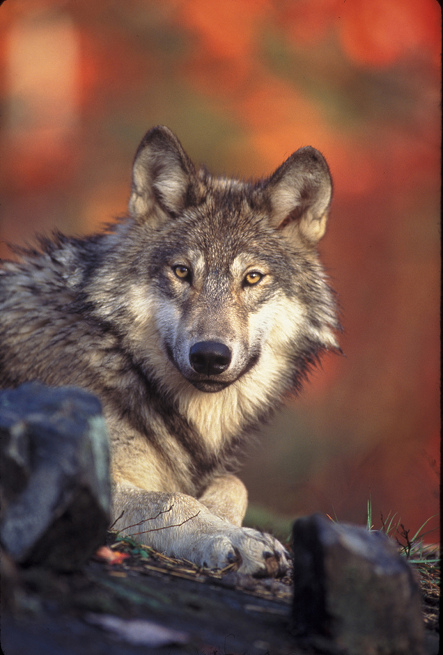The following article first appeared in Earth Island Journal.
How a Campaign of Fear and Intimidation Led to the Gray
Wolf's Removal from the Endangered Species List
"Nabeki" didn't expect everyone to love
her when, in September 2009, she founded the website "Howling for Justice" to
celebrate the return of gray wolves to the Northern Rocky Mountains and to
protest the then-pending wolf hunts in Montana and Idaho. She didn't expect to
fear for her life, either. But after she posted the names of Montana wolf
hunters on her site, the threats began. On a single day in February 2010 the
anti-wolf movement sent to her 3,000 messages. Some of the e-mails expressed
their desire for her to leave the Rockies immediately. Some messages contained
graphic descriptions of wolf killing clearly meant to cause her anguish. "When
I pulled the trigger, I think I saw the wolf cry," one person wrote. "Then it's
[sic] guts where [sic] blown onto the hillside and it moaned." A few of the
messages hinted at attacking her personally.
"Until that day I wasn't thinking about the hatred,"
Nabeki, a professional from California who moved to the Rockies 15 years ago,
told me. Nabeki is an Internet ID, a pseudonym that she asked me to maintain
since she fears for her safety. "The idea that someone can hate you that much
and not even know you is really daunting. It was the first time I got really
scared. To this day I'm still scared." What bothers her the most, though, is
the sense that no one outside the Northern Rockies grasps the peril wolf
advocates face. "I don't know if people realize how serious a culture war this
really is."
For the last few years, a new version of an old war
against the American gray wolf has raged in Montana, Idaho, and Wyoming. Almost
two decades ago, spurred by environmental activists with a vision of restoring
a historic wolf population that had been extirpated, the US Fish and Wildlife
Service (USFWS) captured 66 wolves in Canada and released them into Yellowstone
National Park and central Idaho, where they flourished. To naturalists, wolf
reintroduction seemed morally right, a chance to remedy a previous generation's
crime of wolf extermination.
But to many in the region, the resurgence of wolves
became a source of rage. Wolves killed livestock, infuriating ranchers. Many
hunters saw the wolves as competitors for deer and elk. Yet the fury against
wolves went deeper than what the animals actually did. For decades, the Rocky
Mountain states have been the center of an extreme right-wing culture that
celebrates the image of man as "warrior," recognizes only local and state
governance as legitimate, and advocates resistance — even armed resistance —
against the federal government.
To members of this culture, wolf reintroduction
became a galvanizing symbol of perceived assaults on their personal freedom.
Resistance was imperative. But whereas attacking the federal government could
lead to prison, killing wolves was a political goal within reach — something
the individual warrior could do. So advocating for the killing of wolves became
a proxy battle, an organizing tool to reach out to all those angry about
environmental regulations, gun laws, and public land policies. Since the early
2000s, and with increasing virulence since 2009, anti-wolf activists have
promoted the image of wolves as demons — disease-ridden, dangerous, and
foreign.
The fear-driven demagoguery has worked. Afraid for
their lives, pro-wolf voices like Nabeki have retreated from speaking out at
public forums. Mainstream hunters, ranchers, loggers, and politicians from both
political parties have signed onto the anti-wolf stance. With the public debate
dominated by wolf paranoia — and fearful of wider losses across the West —
conservation groups were pushed into a legal compromise that ultimately failed.
The result is an impending slaughter. On April 11,
Congress removed gray wolves in Montana and Idaho from the endangered species
list and legislated that in those two states, plus Wyoming, all but 300 to 450
of the region's estimated 1,650 wolves may be killed. The remaining wolves will
not necessarily disappear as a regional species, but their small numbers mean
they will become "ecologically extinct," serving no function within the
mountain ecosystem. How this all happened is yet another example of a
dysfunctional political system in which fear — both irrational fear and fear
harnessed for political gain — determines policy.
Every war has its warriors, and Toby Bridges is in the vanguard of the campaign against wolves — an unmatched
propagandist, agitator, and organizer. When I met him in January at Perkins
Restaurant in Missoula, Montana he was dressed the part in faded green hunting
clothes, his graying hair cut short. A manufacturer's representative for
muzzle-loading rifles, Bridges grew up in the Midwest, but visited Montana for
decades to camp and hunt. In 2007, he moved to Missoula with his wife. By then,
some 500 wolves lived in packs scattered among the mountains. Bridges claims
that their presence had utterly altered the state he loved. "I went to places
where I'd been ten to twelve years ago and the game just wasn't there. Instead I
saw lots of piles of wolf scat."
The idea that environmental groups and the Endangered
Species Act had "forced [Montana] to have too many wolves" enraged him. "I
didn't move out here to Montana to watch it all die and I don't mind being
pushy," he told me. In 2009, he founded Lobowatch.com, a website on which he posted furious anti-wolf essays.
As it happened, 2009 was a pivotal time for wolves in
the Rocky Mountains. Because the animals had flourished, the USFWS "delisted"
them as endangered and returned their "management" to state governments in
Montana and Idaho. (Wyoming was excluded because it hadn't developed a
USFWS-approved management plan.) Both states responded by holding hunts in
which several hundred wolves were killed. In response, a coalition of 14
national and local environmental groups (including the Sierra Club and
Defenders of Wildlife) sued the USFWS, arguing that the agency had violated the
Endangered Species Act by subdividing the Northern Rocky wolf population into
two groups, when the wolves in all three states represented a distinct
population. In August 2010, federal judge Donald Molloy ruled in the
conservation groups' favor, and Montana and Idaho were forced to cancel
upcoming hunts.
The court ruling infuriated a right wing already
inflamed by the election of Barack Obama. On Lobowatch, Bridges escalated his
rhetoric. "It's time to fight dirty," he wrote, then informed readers that
xylitol, a readily available artificial sweetener, causes canines to lose
coordination, suffer seizures, and die. "If Donald Molloy goes against the
wishes of today's hunters, there's going to be a whole lot of very sweet [elk
and deer] gut piles and wolf carcasses dotting the landscape this fall."
Bridges also set out to strengthen some important
alliances. One was with Gary Marbut, who serves as the executive director of
the Montana Shooting Sports Association, a powerful lobbying group in Montana
that promotes a broad right-wing agenda including bills legalizing noise
suppressors while hunting, formation of state militia groups, and a law prohibiting
federal law enforcement from making arrests without a local sheriff's approval.
Bridges also connected with Montana State Senator Joe Balyeat, a Bozeman
Republican who is an extremely conservative states' and county rights advocate
and an avid bow hunter. While reaching out to people in positions of influence,
Bridges began addressing hunting groups and publishing on hunting websites such
as Black Bear Blog. And he enlisted the support of Jim Beers, a former USFWS
agent whose leadership in the "Wise Use" movement — which employs a certain
interpretation of the Bible to advocate for increased exploitation of public
lands — had made him famous in the region.
Montana's anti-wolf alliance of ranchers, hunters,
and militia sympathizers is built around some shared myths that focus on the
evils of wolves in general and the Rockies' wolves specifically. The anti-wolf
movement asserts that because the reintroduced wolves were captured in Canada,
they are foreign — alien and un-American. When we met at a Missoula pizza
parlor, Gary Marbut described Canadian wolves as "an invasive subspecies" that
spread out from Yellowstone and Central Idaho and "bumped off and wiped out an
indigenous species of wolf that were smaller, had different pack structures,
and hunted differently." To "prove" this, websites like Lobowatch regularly run
pictures of large, fierce-looking wolves looking ready to attack.
These "foreign" wolves also have brought disease,
specifically E. granulosus, a tapeworm, the myth asserts.
"Wolves in the Rockies dispense billions of microscopic eggs in air and water,"
Marbut said. "When they get into people they cause cysts … that can be fatal.
We are at risk in Montana."
Anti-wolf advocates also believe that it's only a
matter of time before these foreign, disease-ridden wolves attack humans. In
2010, numerous Internet postings told of elk hunters surrounded by howling
wolves and saved only by their guns. One Idaho guide told his clients to "never
leave the camp without a gun and a buddy," because 24 wolves surrounded them.
Val Geist, a retired professor of biology at the University of Calgary, told a
Montana blog that when wolves "sit and stare at humans [it's] a prelude to an
eventual attack." State Senator Joe Balyeat believes that if wolf populations
continue to grow, "someone in Idaho or Montana will be killed or mauled by
wolves within a year, and it may very well be a small child."
The anti-wolf movement thinks wolves threaten
civilization itself. Marbut sent me his 2003 essay, "Wolves Circling the Fire:
Of Beasts and Tyrants." Its first sentence reads: "There was a time in Man's
evolution when he huddled around the nighttime fire gazing outward at the
glowing ring of eyes — the predators who viewed man only as food." A few good
wolves "came in and joined Man at the fire and became dogs." The rest stayed
outside, always ready to attack. According to Marbut, "one might reasonably
view Man's entire development and creation of civilization as a process of
fortifying against wolves."
These claims resonate with many people because they
build on a long tradition in western culture of demonizing the wolf. During the
Middle Ages, the Catholic Church ruled that wolves belonged to the devil:
Demons could take the shape of wolves, as could witches. Puritans then brought
these ideas to America. Minister Cotton Mather called New England before
settlement a "howling wilderness." Asked to investigate Salem's alleged witch
infestation, Mather concluded in his book, On Witchcraft, that
"Evening Wolves" (werewolves and witches) were but another of the Devil's tests
as New England passed from "Wilderness" to the "Promised Land."
These sentiments remain alive in the Rocky Mountains
today. Jim Boedner, director of natural resources for the Montana Livestock
Growers Association, told me that wolves kill cattle, make them sick from
"stress," and scare elk herds down from the mountains onto grazing fields,
where they compete with cows for forage. State Senator Balyeat — who wore a
turquoise shirt with images of rust-colored elk the day I interviewed him in
his capitol office — keeps a computer file full of photos of deer and elk calf
remains. "The key thing that animal lovers don't understand about wolves is
that there's a difference between wolves and other predators," he said.
"Wolves, grizzlies, and mountain lions are all killing machines, but wolves, in
distinction, are also a breeding machine. I am an award-winning CPA, but it
doesn't take a CPA to do the math." By Balyeat's calculations, wolves have a 30
percent annual reproduction rate. If there are 550 wolves in Montana, and each
wolf eats 46 elk a year, in ten years 5,830 wolves will eat 258,180 elk.
"That's more elk than we have in the entire state of Montana!" Balyeat says.
While arguing the specifics of wolf behavior, the
anti-wolf movement unites segments of the political right by emphasizing
wolves' connection to a shared enemy: the federal government. Starting in the
1970s, ranchers in the self-described "Sagebrush Rebellion" claimed that
because the National Forest Service had given them permits to graze livestock
on public lands, that land had in essence become their private property.
Therefore the imposition of environmental laws violated their rights. Some,
like Wayne Hage, founder of the private property rights group American
Stewards, go even farther. They say that the federal government should have
sold its holdings in the West to ranchers in the late nineteenth century, but
instead appropriated them. Like this "taking" of land to create national parks
and forests, reintroducing wolves that then kill livestock — ranchers' private
property — represents another act of government domination.
According to Jim Beers, the wolf reintroduction in
the mid-1990s was the result of federal government crime: The Clinton
administration had illegally taken $60 million that hunters and fishers had
paid in excise taxes on guns and gear and used it to pay for wolf
reintroduction. Beers told this story repeatedly to hunting groups; it still
circulates widely on anti-wolf websites.
To Gary Marbut, wolf depredation represents a "theft"
from hunters. He told me that Montana's game herds were "a savings account we
were building up for our children and grandchildren. The wolf advocates elected
to raid that savings account to feed their pet critters."
Suzy Foss, a rancher in the Bitterroot Valley and a
county commissioner, said that wolves are now in Montana because "monkeys in
some government agency in a Washington high-rise think they're good for us.
They will destroy our society."
"Not one wolf from Canada volunteered to come down
here — they were drugged," she told me. She said that many Bitterroot Valley
residents had told her that elk stayed out of the woods because "they're
terrorized," that their livestock had been killed, and that they themselves had
been "stalked or circled by wolves." This, she said, is the reason why many
people in the area carry guns.
The anti-wolf activists speak
passionately, sometimes even persuasively, about their cause. But none of their
claims are true.
Ed Bangs, director of wolf recovery in the Northern
Rockies for the US Fish and Wildlife Service, rejects the idea that Canadian
and Rocky Mountain wolves are two different subspecies. "Once there were
contiguous wolf packs from what is now Mexico City to the Arctic Ocean," Bangs
told me. They interbred and formed one species. Yes, the wolves in southern
Canada ran a bit larger. But that's because of what biologists call 'Allen's
Rule' — "as you move north, body size gets larger to preserve heat." Hunters
did not kill any "giant" wolves in the 2009 wolf hunts; of 188 killed in Idaho,
the largest weighed 127 pounds, the average less than 95. What about those huge
wolves shown on Lobowatch? They're actually Arctic wolves, which don't live in
the Rockies. And while many wolves do carry tapeworms, scientists from the US
Geological Survey Wildlife Health Center report that, "We know of no known
transmission of E. granulosus from a wolf to a human."
Neither is it true that wolf packs are lying in wait
for the region's school children. In the entire twentieth century, wolves
attacked about 15 people in North America, killing none. (In 2010, wolves did
kill a woman jogging on the outskirts of her Alaskan town.) In contrast,
domestic dogs bite about one million people a year and cause about 18 deaths,
mostly of children.
I asked wolf biologist Jay Mallone of Kalispell,
Montana about the hunters' stories of circling wolves ready for attack. He
sounded jealous, and said: "For periods of time, all of us wolf biologists have
lived among the wolves we studied and never been approached. I wish they would.
It would make studying wild wolves a lot easier!"
Also: Wolves aren't killing all of the West's big
game. Even the Rocky Mountain Elk Foundation, a critic of wolf reintroduction,
reports that from 1984 to 2009, the number of elk in Idaho went up 5 percent,
in Wyoming 35 percent, and in Montana 66 percent. True, some local declines
have occurred, and sometimes wolf depredation is a factor. In 1995, when wolves
were first introduced in Yellowstone, there were 16,702 elk in the park. By
December 2010, only 4,635 remained. But the cause of this decline is under
debate.
Some studies point to bear predation, others to
hunters (who are allowed to kill elk that have moved beyond the park), and
still others to climate change — increased summer temperatures reduce
nutrition, making elk more vulnerable.
It's equally false to say that wolves are "breeding
machines." Predator populations change when numbers of prey decrease; climate
and habitat conditions also influence reproductive rates. And while wolves do
sometimes kill cattle and sheep, the numbers are surprisingly small. Federal
statistics report that of Montana's roughly 2.5 million head of cattle, wolves
killed 97 in 2009 and 87 in 2010. Wolves killed 202 of Montana's 250,000 sheep
in 2009 and 64 in 2010. Suzy Foss's county lost one cow to wolves in 2009 and
two in 2010.
Carter Niemeyer, who worked for Wildlife Services in
Montana from 1973 to 2000 and investigated more than 100 cases of reported wolf
depredation, says he believes that only about 5 percent were verified kills.
Pressure on investigators from ranchers and state officials corrupted the
system, he writes in his book, Wolfer: A Memoir:
"Everyone's kids go to the same schools; everyone shops in the same grocery
store. If a rancher thinks a wolf killed his cow, the investigator isn't going
to argue with him." Niemeyer told me he thinks the system perpetuates wolf
killing. "We have a tremendous amount of livestock loss reported, but very
little documentation to prove it. These claims become statistics and statistics
drive the urge for predator control."
Ranchers' most ambitious claims — that because they
hold grazing permits on federal lands that these lands are their private
property — are also specious, dismissed by the United States Supreme Court in
2000. "In Public Land Council v. Babbitt the justices voted nine-to-zero that
grazing permits are a license, not a property right," said John Marvel,
executive director of the Western Watersheds Project. In fact, the cattle
industry is a major recipient of the very type of government largesse that the
right often decries as welfare. The federal government charges ranchers $1.35 a
month for a cow and calf to graze, when it costs the US Forest Service at least
$12.25 per head to maintain mountain rangeland. "The low fee," Marvel said,
allows "ranchers to be compensated for risks of grazing on public lands, which
includes risk of depredation." Similarly, there is no legal basis to the idea
that individual hunters "own" deer and elk as their "savings account" because
they pay taxes on guns. As Marvel put it: "Groups like American Stewards and
people like Suzy Foss are living in a fantasy world."
The fantastic claims made by the right
wing did not go unchecked. Between 2009 and 2010, the major national
environmental groups focused on their lawsuit against the USFWS's partial delisting.
Mike Leahy, regional director for Defenders of Wildlife, told me that his group
decided that the most important fight was "at the national level." Meanwhile, a
loose confederation of local wilderness activists tried to counter the
anti-wolf propaganda by showing up at public hearings in Idaho and Montana and
offering a defense of the wolf's place in the Rocky Mountains.
Most the wolf supporters were relative newcomers to
the area. They were middle-aged boomers who had moved to Montana and Idaho to
live near wild and beautiful lands. Many of them identified as
conservationists: They had read the classic environmental books on the
interconnected web of life, they knew about the Native American spiritualism
that understands animals as symbolic kin. They included Nabeki, a California
transplant who became involved in protecting roadless areas and limiting
off-road vehicles. Jerry Black was another one, a retired pilot and long-time
wetlands activist from Washington who thought he would just fish and hike when
he moved to Missoula to be near his children. But the anti-wolf movement
repulsed him. "It's as if wolf advocates are two-legged wolves," Black
explained, "and wolves represent four-legged environmentalists." Marc Cooke
moved from the East Coast to pursue wildlife photography, only to find the
wildlife under siege. In Idaho, Ann Sydow and Nancy Taylor, co-chairs of the
Northern Idaho Wolf Alliance, shared a common interest in showing real (albeit
captive) wolves to people — "wolf ambassadors" is what they call them — and
could not stomach the attacks on the animals. Lynne Stone, an Idaho settler
from Washington, had helped form the Boulder White Clouds Council, which tried
to stop mines from dumping cyanide and mercury into Idaho's rivers. That work
led her to becoming a wolf advocate.
Between 2008 and 2010 this collection of part-time
activists did whatever they thought would work to resist the wolf hunts. Jerry
Black wrote federal agencies to try to find out why wolves killed by Wildlife
Services were photographed with school children. Lynne Stone tried to scare
wolves away from livestock with blank shotgun shells. Marc Cooke showed up at
state hearings to argue for minimizing the number of wolves allowed to be
killed. Nabeki started her Howling for Justice website and a Facebook
affiliate, Wolf Warriors.
These ad-hoc efforts were not what you would call a
powerful movement. But the fact that anyone would stand up for wolves enraged
the wolf hunters. The fury the anti-wolf movement had directed toward animals
was extended to humans.
As Gary Marbut told me: Just as wolves prey on
animals, wolf advocates prey on society. "They are feasting on our savings
account, our culture, our way of life, in order to impose their own culture of
wolves." They, too, were foreigners, people who "grew up in cities." Anti-wolf
bloggers have called the wolf defenders "pieces of communist crap" who "DO NOT
belong in my country, who should be deported … and that's my second choice of
things to do with you."
Between 2009 and 2011 the viciousness escalated.
Lynne Stone received an e-mail photo of a dead wolf pup lying in the back of a
pickup on December 24; the accompanying text read, "merry christmas." Soon the threats
extended to the activists themselves. Ann Sydow opened her local paper to find
a letter to the editor recommending that she "go for a walk in the woods and
not come back." Just showing up to a public meeting became dangerous, Marc
Cooke explained. "When I go, they stare at me," he said. "Half of them have pistols
at their sides. They say 'Marc, we know who you are. We know where you
live.'"
The intimidation
worked. Afraid for their lives and their families, regional wolf advocates
stopped participating in public hearings held by fish and game agencies and legislative
committees and retreated to the relative safety of the Internet to spread their
message. In theory, government officials are supposed to run public meetings in
an inclusive manner that, in the words of Montana administrative rules, promote
"social tolerance." But in the experience of Travis McAdam, executive director
of the Montana Human Rights Network, "Public officials never get up and remove
the people who scream at meetings. The same ones who are doing cat calls are
carrying guns, and they're making democracy fail." Soon, the voices of the wolf
haters became the only ones heard in the policy making process.
With few, if any, local constituents speaking up on
behalf of the wolves, the political calculus for Montana and Idaho politicians
was easy. Office holders across the political spectrum raced to denounce
wolves. Montana's sole congressman, Republican Danny Rehberg, repeatedly spoke
against wolf reintroduction and federal protection. After Judge Molloy's August
2010 decision relisting wolves under the Endangered Species Act, Rehberg
introduced a bill in the House of Representatives to remove this protection —
in essence, a Congressional nullification of the ESA. Montana's Democratic
Senators Jon Tester (who faces opposition from Rehberg in the 2012 election)
and Max Baucus then introduced a similar bill in the Senate.
In October 2010, Idaho's Republican governor, Butch
Otter, ordered state wildlife managers to "relinquish their duty to arrest
poachers." Montana Governor Brian Schweitzer, a Democrat, announced that
Montanans could open fire on wolves in the northern part of the state if they
felt their livestock were endangered. And in February 2011, Idaho Congressman
Mike Simpson and Senator Tester placed into the federal budget bill a rider delisting
wolves.
Having successfully captured both Republicans and
Democrats in the region, the far-right-wing offensive then shattered the
environmental movement's will. Worried that Congress would pass one of the
bills and set a dangerous precedent allowing political intervention against any
species listed as endangered, all of the national groups that had filed suit to
protect the Rockies' wolves (with the exception of the Humane Society of the
United States) announced they had reached a settlement with the Department of
the Interior (which oversees the USFWS). The agreement basically reversed the
environmentalists' 2010 legal victory putting wolves back on the list of
endangered species.
Besides the Humane Society, three regional groups
declined to settle. John Marvel, executive director of the Western Watersheds
Project, explained why his group refused to go along with the deal: "Our board
of directors came to the conclusion that the outlook for wolves from this
settlement or from Congressional delisting was the same and it was
inappropriate for us to assist in this outcome." That analysis quickly proved
prescient. Neither John Tester nor Danny Rehberg nor Mike Simpson withdrew
their bills. Then, on April 9, Judge Donald Molloy rejected the proposed agreement,
and kept Montana and Idaho wolves on the endangered species list. Almost
immediately, Congress rendered his ruling irrelevant by passing the budget with
the anti-wolf rider included. The rider will also remove from the endangered
species list some wolf populations in Washington, Oregon, and Utah.
The far right's campaign to scapegoat wolves thus
succeeded. Although the courts were prepared to uphold the Endangered Species
Act, the anti-wolf voices dominated the political contest. The national organizations
had lost track of the basic reality of politics — namely, that all politics are
local — and instead concentrated solely on legal maneuvering and online
petitions. Local wolf defenders were essentially abandoned; outnumbered, it was
no surprise that they should lose. Fear of wolves — and hatred of what they
symbolized — spread from the far right, to the Republican Party, to the
Democrats. And then that fear, or some form of it, was internalized by the
mainstream environmental movement. Afraid of witnessing an even broader
weakening of the ESA, environmental groups decided to sacrifice wolves,
calculating that doing so might save other species covered by the act.
Wolf blood will flow across the Rocky Mountains this
fall and winter. For the right, that blood will represent an impressive
victory. For wolf advocates, it means grief. Their only hope lies in the belief
that the killing might backfire, creating a national sense of shame. Nabeki,
for one, thinks the war is not over. "The delisting has galvanized the
grassroots movement," she said. "People are so outraged about this. They're
becoming more bold."
And there is hope in the wolves themselves. When I
visited Montana, activists from both sides whispered to me, as if sharing a
secret, "You know, wolves are really smart." Perhaps
their intelligence will enable them to survive. They will climb higher into the
mountains, move about only at night, and hide, somewhere, until times change.n
Marc Cooke helped arrange interviews with wolf
hunters and advocates for this story.
Image by Gary Kramer/USFWS, courtesy of Creative Commons license.









